Shining brightly - the early years
I had to try hard to tell the story of my maternal grandmother, Aurelia, without making her a tragic figure. She deserves more than that. So let me say quickly that she was born in January 1918 after her dad had died in WW1 and she died in December 1945 soon after she gave birth to her first child, Mariana, my mother. But she packed a lot in these not quite 28 years.
What I have of her are about 40 photos, three of her gouaches and a few folk costumes pieces. Most of the information I have on Aurelia comes, obviously, from my mother. She got it herself from her grandmother, Constance, Aurelia’s mother(her story here) and from a few other relatives. Even I had one such story. Aurelia had a cousin that she was close to. I met this cousin a few times, most memorably, when I was about ten years old. The cousin, at that time an old lady, seems to have had a bit of a life-long girl crush on Aurelia and was saying how clever, kind, talented and charismatic my grandmother had been. Addressing her daughter, Vivi ( middle name Aurelia!) and my mother, she said “I speak to Aurelia all the time. It’s like you two speak on the phone”. The thought of this direct phone line to the afterlife was very funny to me at the time so I started laughing but they didn’t pay me any attention. The cousin’s affection did not extend from Aurelia to, her daughter, my mother which makes the next bit even more surprising. Much later, in 1998, when I was a postgraduate student in America and my mother was visiting me, she, unexpectedly, needed a major heart surgery, quintuple bypass. It was a very stressful time and the last thing on my mind was to inform the cousins. Thankfully, my mother recovered and, eventually, got home. As soon as she was back, she got a phone call (on a normal landline!) from this cousin of hers, once removed. Before my mother got the chance to say anything, Vivi blurted “Phew, I am so glad to catch you. I have been calling for ages. Mum was nagging me to call you all the time. She had a dream and Aurelia told her you were in trouble. How are you?”. OK, what do I know to make fun of afterlife phone lines?
Back to my grandmother's story. I will tell the story of Aurelia’s early years through the photos I have. For all the tragedy of never knowing her war hero father, I think her upbringing was quite happy, under the care of her loving and wise mother, Constance. They were quite well off, and had a good social standing in their community with Constance the respected teacher of the primary school and known as “The lady” in the village (even I heard this name on one rare visit to the village during my childhood). They also had the support of their extended family living in the same county and knew socially the better-off families in the area.
Aurelia attended primary school in her village and was taught by her mother. I have a few photos of my grandmother's early school years. These are studio photos: she is either wearing a school uniform or a folk costume, sometimes with other girls, likely cousins or school friends. I tried to colourise some of the photos to get a feel for the uniforms, costumes and clothes.
This is the earliest photo I have of my grandmother, in her primary school uniform.
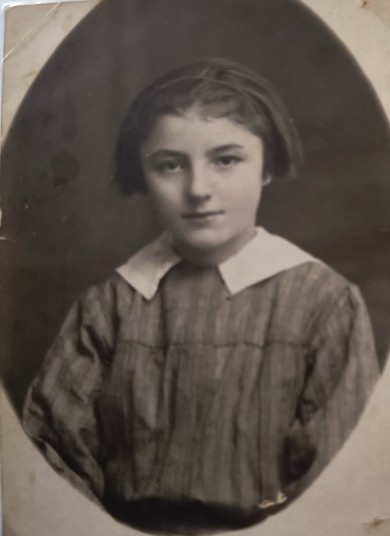
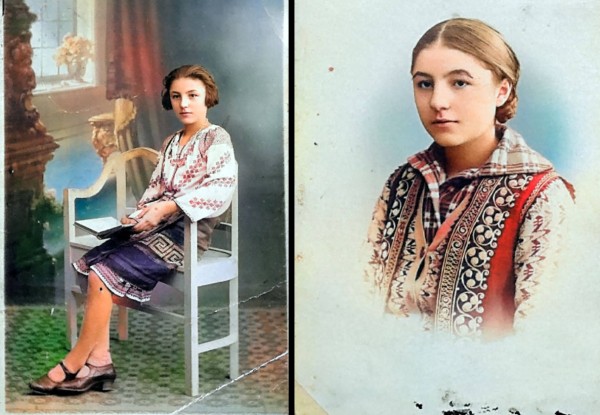
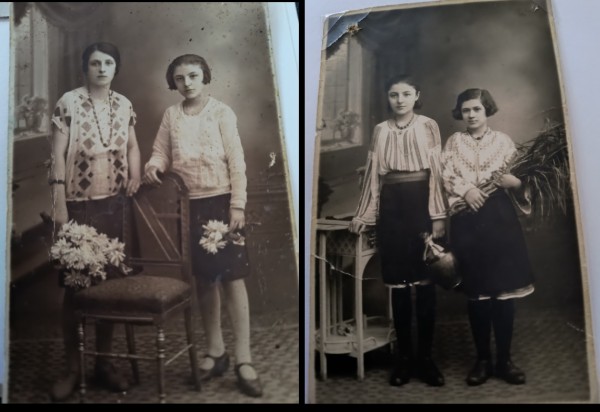



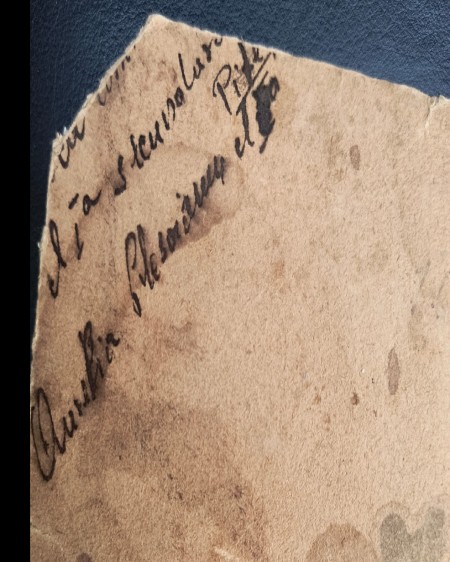
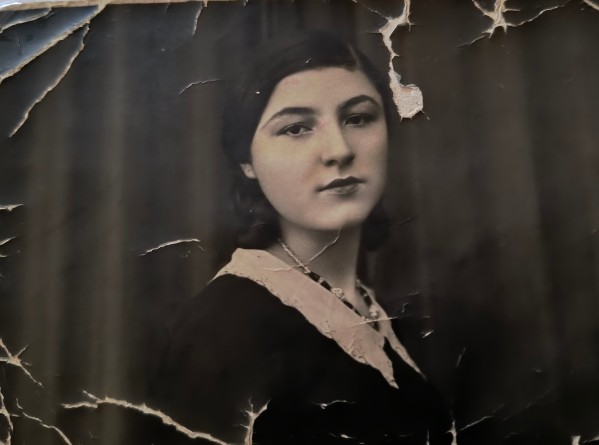
Most of the photos until now were done at a photographer studio. They are nice but more artificial in my view. The later ones are more spontaneous and interesting. As far as I know, Aurelia and her mother never had a camera so someone else brought a camera along, took the photos and gifted them these photos that I now cherish. So, the frequency might be a bit random. For example, I see evidence of a longer trip Aurelia took from one photo described below, but I don’t think it means it was the only trip, more that this is the time when there was someone with a camera to record it.
I love this photo of my grandmother though for current sensibilities, it could look a bit disrespectful. It shows Aurelia in the middle, with two friends against a WW1 memorial representing soldiers that died in the battle around a place called Predeal. Zooming in, it is possible to read the text on the monument, including the location.
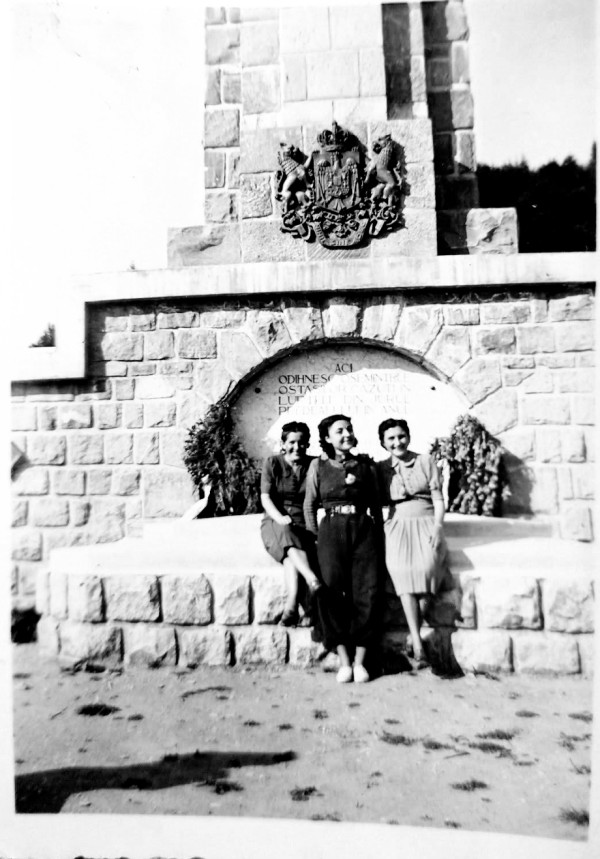
I am not sure about the other girls, but she was sort of visiting her dad and a brief moment of youthful exuberance is to be forgiven for all the loss they suffered. I am glad to see her smile and enjoying herself rather than being solemn. So much tragedy in her life, it’s lovely to see her looking happy.
I looked up the monument and found this recent photo of it (credit to the photo owner)
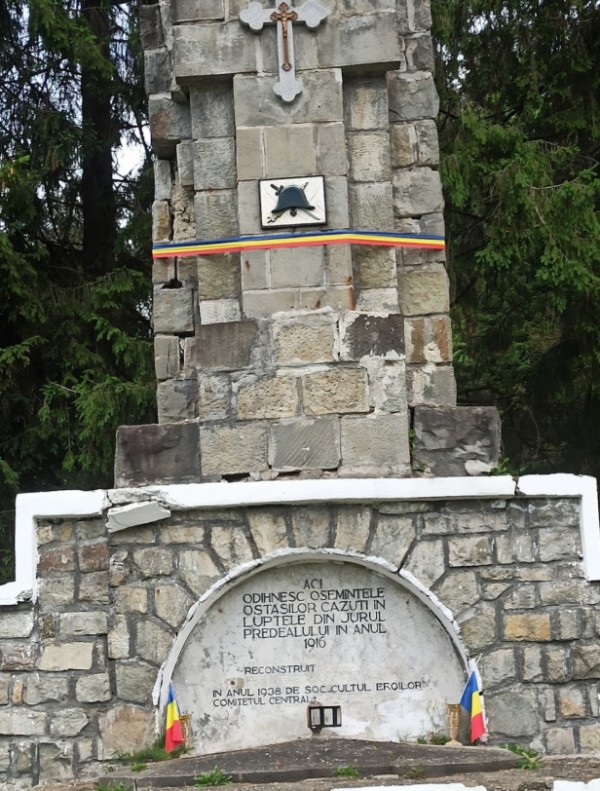
The monument is not too close to the county Aurelia was in at the time: 3 hours by car or 4:30 by train if you travel today.
Was this a school trip? Was this a thing in a ’30s girl school? A private trip? Surely three teenagers would not travel alone.
Anyway, I am glad to see evidence that she got to Predeal where I went many times too.
According to my great-grandmother Constance, via my mother, Constance and Aurelia had one of these small carriages
like this one but they, probably, used it for shorter distances.
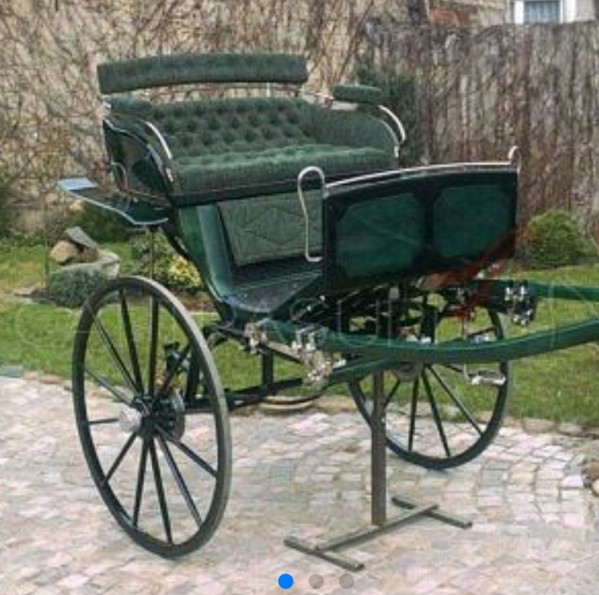
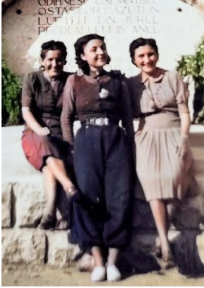
According to various resources, wearing trousers at that time, in 1932, was quite daring.
For example, in this newspaper article it says that
the first type of trousers that emancipated Romanian women wore were harem pants. Is this the name for what she is wearing?
On the streets of Bucharest, the first ladies started to wear these from 1928 but there was a lot of social resistance to it.
So four years after the first women of the country wore trousers, here she is doing it at 15, I think it is pretty cool.
Even the shoes, as much as you can see them, look like some comfortable, almost sport shoes.
In no other photo, Aurelia wears trousers. Maybe it was a rebellious teenage phase, but lovely to see. Good for you, grandma!
Aurelia was a member of the Girl Guides movement as these photos of her in the uniform, in front of her house show.
Looking on their blog, in Romania, the girl scouts organisation was set up in 1930.
Aurelia was 12 at the time, so the organisation was quite new when she took part in it. I would say in the left photo she is really young, pre puberty, so she must have been among the first intakes.
The second photo is dated on the back, 1 september 1940, so she must have been taking part as an adult too at 22.
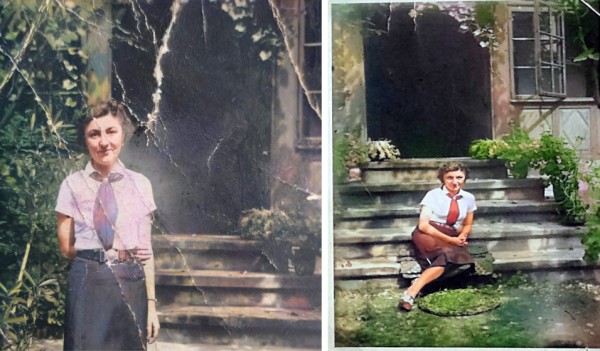
Rather unsurprising, young Aurelia started to be courted and had proposals quite early on. It is funny to see some of the social customs of that era reflected in the photos in this way. Obviously, I am not interested in gossiping about the relationships of long gone people. But I am curious about the social mores of that era as reflected from these photos. I realised that I know more about, say, the courtship, friendships, relationships, marriage rules in Regency England through the Jane Austen adaptations than the more recent, interwar period, in my own country, except for a few novels that do not cover her social class, they go either higher or lower. So my curiosity is a bit anthoropological as well as personal.
There are a couple of photos from this stage and they have on the back decorous courting messages, written like on a postcard. It must have been an option at the photographer to have it printed with the markings of a postcard on the back of the photo. It seems taking photos and giving them back to the girl with a romantic message was a way a form of courthship.
For example, this photo shows Aurelia with her mother, Constance at their home and a young man and his dad as the young man came to ask for Aurelia hand in marriage. Did the men bring a camera and a photographer around? That seems a bit overconfident. There is a date on the back, 27 august 1935, when Aurelia was 17. Interesting what they were all wearing for this occasion: suits and ties for men, a traditional folk attire for the mother and a more urban but conservative attire for the girl that made her look older than her years. Do I read to much in this photo is I say she looked less than ecstatic?
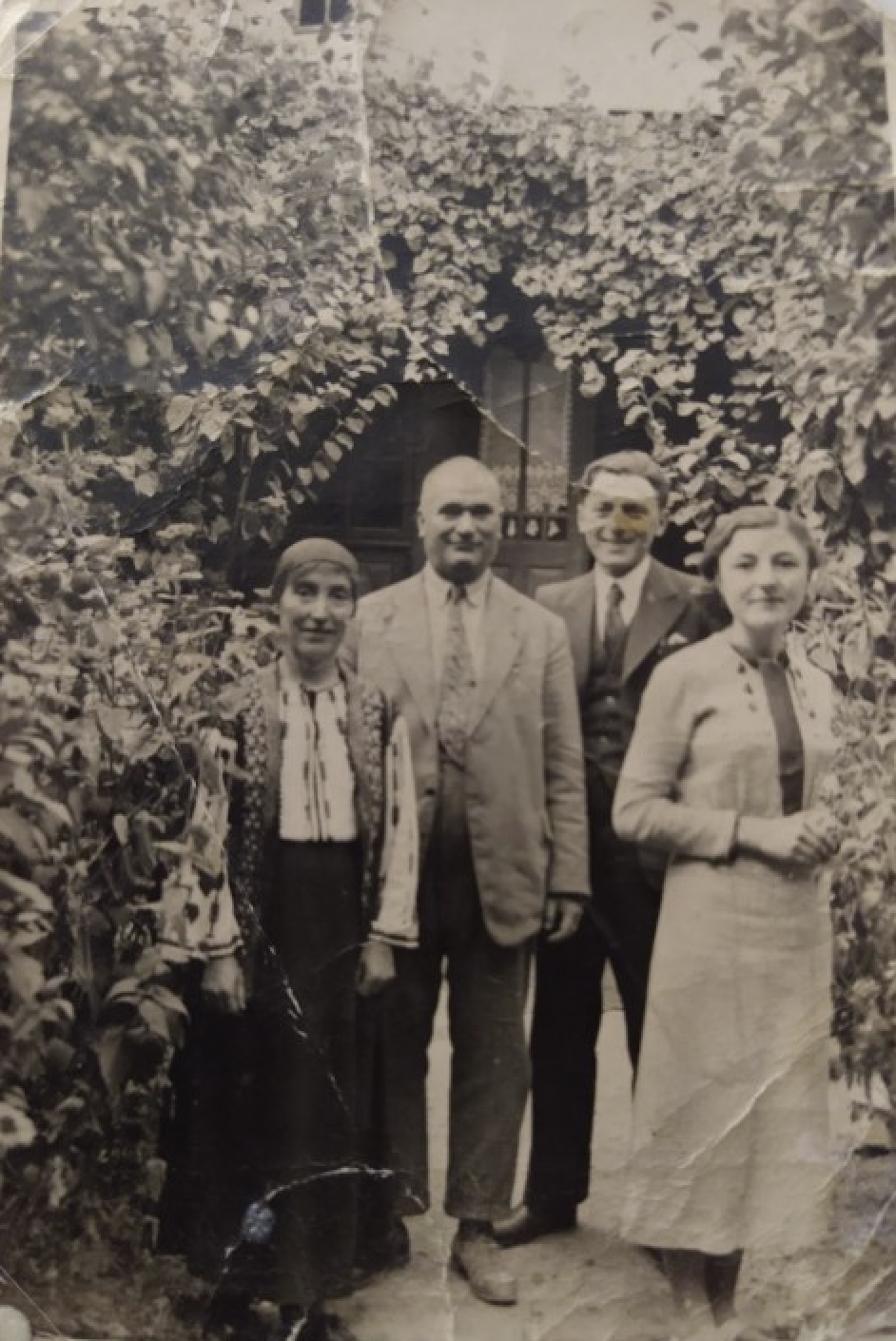
This was the last summer, between year 7 and 8, of the normal school( teacher training school).
Then, there are two other photographs. The first shows Aurelia on the right having fun and refreshments with her friends.
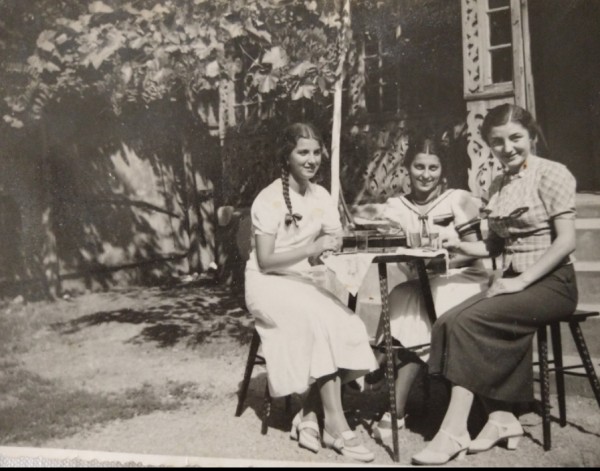
The message on the back: “The expression shows the character, the eyes reveal the soul and both the person. Who would think I was the photographer?” There is a date, place and signature. The place is another village next to hers. The signature includes a job title “Pretor”, that I had to look it up. It sounds Roman and this is indeed its origin and it was a local government job, the next level down from the county prefect. The young man must have thought it was impressive enough to include it in a romantic context.
From the same occasion, a second photo includes the young man, the brother of one of her friends.
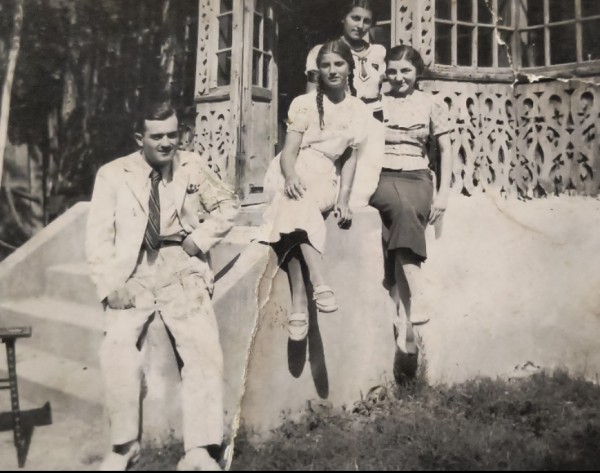

Aurelia did not want to marry young. The bright lights of the Paris of the East, at its best in all its modernist, Art Deco glory, were beckoning.
As soon as she graduated with her teaching qualification, Aurelia moved to Bucharest. I loved to discover just by looking carefully at these photos and with a few quick searches how modern and forward looking my grandmother was, how she was involved with so many brand new things: the school, girls guide, fashion choices. Once might be an accident, but this looks more like a pattern. Her mother must have been onboard with these and supported her all the way.
What happened next in this short but fascinating life will be a subject of my next story.